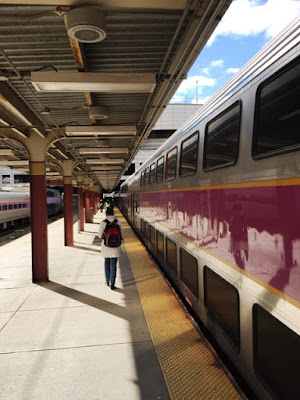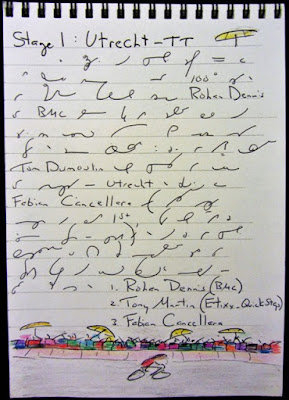With winter 2016 quickly becoming history, I welcomed in spring this past Saturday with a long Brompton bike ride from my home on Boston's South Shore all the way to Harvard Square in Cambridge. I saw so many wonderful things along the way.
I rode the bike lanes through Dorchester, by the neighborhood's iconic triple-deckers:
Then after a quick dash up D Street in South Boston, I stopped to rest on one of the wide benches that line the Seaport District, looking out on the commercial fishing boats that dock at Boston Fish Pier. Here's a watercolor I did of that scene when I got home (click to enlarge):
After my short break by the pier, I continued riding along Atlantic Avenue's bike lanes into downtown Boston, stopping for breakfast at the
Equal Exchange Cafe coffee shop near Boston Garden:
Normally this sidewalk would be full of people, especially after a basketball or hockey game at the Garden. But it 7:00 AM on a Saturday, so all was quiet.
How nice it was to simply bring my neatly folded Brompton inside and tuck it under the table as I ordered a bagel and iced coffee from the friendly staff.
Another great thing about the Brompton is that because of its small size, it's easy to walk the bike to become a pedestrian when necessary. This allowed me to make my way from Boston to Cambridge along one of the city's most magical secret spaces ... the network of little public bridges and catwalks across the Charles River locks:
My meandering journey across the river was rewarded by this view of the Zakim Bunker Hill Bridge...
... and a chance to have a little fun playing the "
Charlestown Bells" -- an interactive work of public art by Henri Matisse's grandson, Paul Matisse. You pull various handles to ring the tubular bells that span the walkway's fence.
Each handle even has the note it plays etched into the steel.
I then got back on my bike and rode the paths through the fairly new Paul Revere and North Point Parks. The magical thing about Paul Revere Park is that it makes accessible -- and beautiful -- a space that is usually left to become to dark, dusty, and dangerous: the space beneath the bridge:
I'll have to take a better photo of this sometime, because the picture I took doesn't capture how light, cool, and fun this area is. There are always people around, strolling, running, walking their dogs, or just enjoying the sun. And directly under the bridge are stone sculptures, a skateboard park, and then a pedestrian/bike bridge that lifts you out from under the bridge into the beautiful garden area of playgrounds, landscaping, and well-tended bike lanes that is Cambridge's North Point Park. In fact, the bike path is part of the Maine-to-Florida
East Coast Greenway.
The Greenway has a long, long way to go before being complete. But hopefully someday the dream will become a reality.
I then continued my ride onto the bike lanes of Kendall Square and MIT, some of which are completely separated from the street.
Turning onto the bike lanes of Mass. Ave, it wasn't long until I reached my destination: Harvard Square. I didn't take any photos there, mainly because I've been to Harvard Square thousands of times. But you can read about its bike lanes on
this earlier post I wrote.
Happy with this long and wonderful ride, I decided it was time to head home. So I hopped on the Red Line subway for a quick dash back to the South Shore (again, super-easy with a folded Brompton). But unfortunately I forgot that the T was doing construction that day along the Longfellow Bridge between Cambridge and Boston. So they were busing passengers over that part of the route. Argh!
I could have simply carried my Brompton on the bus, but instead I got back on my bike at Kendall Square and retraced my route along the North Point Park bike paths...
... over the creaky gangways of the Charles River Locks...
... and into the North End, where I took a long way around, leading me to this:
This is a very special section of the
Rose Kennedy Greenway, the linear park that snakes its way through downtown along the old path of the I-93 elevated highway. The highway now runs underground -- the end result of the tumultuous Big Dig project that I was a witness to for well over a decade. This section of the Greenway is designated the
Armenian Heritage Park, honoring metro-Boston's large Armenian community.
The labyrinth and the dark polygonal sculpture (on the upper-left of the labyrinth) represent the constantly growing and unfolding immigrant experience. The sculpture is reconfigured each year into a new shape, symbolizing the different ways immigrants reshape their own lives in their new home. The sculpture is dedicated to the lives lost in the Armenian Genocide of 1915-1923.
I stopped here for a bit to take in the meaning of this space, and then I rejoined downtown Boston's bike lanes to ride on to South Station where I folded up my Brompton, got back on the Red Line, and completed my journey home.


































